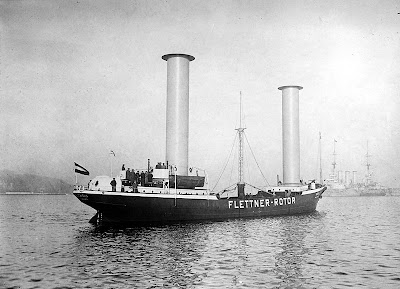The picture above, taken in Potsdam in 1925, shows the world's first rotor ship - also called Flettner ship after its inventor, German engineer Anton Flettner. (Flettner applied for a patent for his invention in 1922).
In a Flettner ship the rotorsails take advantage of the Magnus effect - a force acting on a spinning body in a moving airstream - for propulsion.
 |
| The Buckau (image by wikipedia) |
The vessel was a refitted schooner which carried two cylinders (or rotors) about 15 metres (50 ft) high, and 3 metres (10 ft) in diameter, driven by an electric propulsion system of 50 hp (37 kW) power. In 1926, a larger ship with three rotors, the Barbara, was built by the shipyard A.G. Weser in Bremen.
Following completion of its trials, the Buckau set out on her first voyage in February 1925, from Danzig to Scotland across the North Sea. The rotors did not give the slightest cause for concern in even the stormiest weather, and the rotor ship could tack (sail into the wind) at 20-30 degrees, while the vessel with its original sail rig could not tack closer than 45 degrees to the wind.
On 31 March 1926, the Buckau, now renamed Baden Baden after the German spa town, sailed to New York via South America, arriving in New York harbor on 9 May.
It was found at the time that the rotor system could not compete economically with the diesel engines that were also being developed for ships in this era. Flettner turned his attention to other projects and the rotors were dismantled. Baden Baden was destroyed in a Caribbean storm in 1931. Due to the rising cost of fossil fuels, as well as environmental concerns, there has been renewed interest in the concept in the later 20th century, starting with Jacques-Yves Cousteau's Alcyone in 1983.
More recently Wärtsilä, the Finnish company marine engine company, has unveiled a design for a large cruise ferry that uses LNG to power the main engines and Flettner rotors using wind for additional power. On June 6 this year, Wärtsilä's head of Concept Design, Ilkka Rytkölä, showed this picture of the design in a presentation he gave at the Centrum Balticum:
 |
| Wärtsilä's futuristic ferry design. |
 |
| The German E-ship, using rotors in the rear was launched in 2008. (image by wikipedia) |
 |
| The University of Flensburg's Flettner catamaran. (image by wikipedia) |
 |
| Finnish engineer V.S. Savonius on board his rotor-driven sailing boat. (1925) |
Rotor-driven ships and boats appear to have made a come-back in the beginning of the 21st century. Only time will tell whether they will play a serious role in the future.
PS
Added on April 3, 2017:
It seems that rotor technology indeed is making a come back:
Finnish cleantech firm Norsepower claims its rotor sail technology will help the shipping industry become environmentally friendlier. This week the company announced that a pair of its tall, cylindrical sails will be installed for long-term trials on a Maersk Tankers vessel in 2018.
More information here.

The Savonius boat is NOT a Flettner Rotor, as the most casual inspection will reveal they are not plain cylinders, but some kind of Savonius Rotor
ReplyDeleteIf you read the text you will note that I do not say that the Savonius boat is a Flettner Rotos:'
Delete"However, the world's first first rotor-driven sailing boat - with the wind powering the wing rotors - was constructed by the Finnish engineer V.S. Savonius already in the 1920s. (Flettner's rotors were driven by engines)"